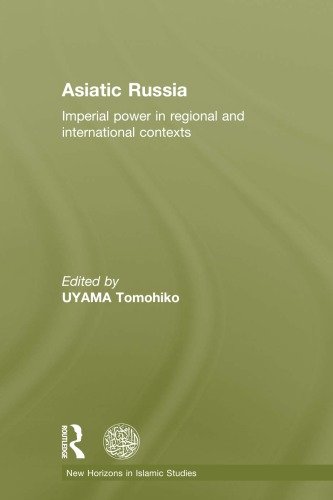1) Asiatic Russia: Imperial Power in Regional and International Contexts – Tomohiko Uyama
Routledge | 2012 | PDF
Although the Russian Empire has traditionally been viewed as a European borderland, most of its territory was actually situated in Asia. Imperial power was huge but often suffered from a lack of enough information and resources to rule its culturally diverse subjects, and asymmetric relations between state and society combined with flexible strategies of local actors sometimes produced unexpected results.
In Asiatic Russia, an international team of scholars explores the interactions between power and people in Central Asia, Siberia, the Volga-Urals, and the Caucasus from the 18th to the early 20th centuries, drawing on a wealth of Russian archival materials and Turkic, Persian, and Tibetan sources. The variety of topics discussed in the book includes the Russian idea of a “civilizing mission,” the system of governor-generalships, imperial geography and demography, roles of Muslim and Buddhist networks in imperial rule and foreign policy, social change in the Russian Protectorate of Bukhara, Muslim reformist and national movements.
The book is essential reading for students and scholars of Russian, Central Eurasian, and comparative imperial history, as well as imperial and colonial studies and nationalism studies. It may also provide some hints for understanding today’s world, where “empire” has again become a key word in international and domestic power relations.
2) Empire, Islam and Politics in Central Eurasia – Tomohiko Uyama
Sapporo: Slavic Research Center, Hokkaido University | 2007 | PDF
CONTENTS:
• PART ONE: The Russian Empire and Central Eurasia
1. Dār al‐Islām under Russian Rule As Understood by Turkestani Muslim Intellectuals – KOMATSU Hisao
2. A Particularist Empire: The Russian Policies of Christianization and Military Conscription in Central Asia – UYAMA Tomohiko
3. Maktab or School? Introduction of Universal Primary Education among the Volga‐Ural Muslims – NAGANAWA Norihiro
4. Central Asia in Early Photographs: Russian Colonial Attitudes and Visual Culture – Margaret DIKOVITSKAYA
• PART TWO: The Revolution and Intellectuals
5. The Fascination of Revolution: Central Asian Intellectuals, 1917–1927 – Adeeb KHALID
6. The Alash Movement and the Soviet Government: A Difference of Positions – Mambet KOIGELDIEV
• PART THREE: Mass Deportations under the Soviet Regime
7. Deportation of the Kalmyks (1943–1956): Stigmatized Ethnicity – Elza‐Bair GUCHINOVA
8. Nationalities Policy in the Brezhnev Era: The Case of Deported Nations – HANYA Shiro
• PART FOUR: Local and Global Aspects of Islamic Revival
9. Fundamentalist Challenges to Local Islamic Traditions in Soviet and Post‐Soviet Central Asia – Ashirbek MUMINOV
10. Islamic Resurgence in the Modern Caucasian Region: “Global” and “Local” Islam in the Pankisi Gorge – George SANIKIDZE
• PART FIVE: Post-Soviet Political Developments
11. An Analysis of the Internal Structure of Kazakhstan’s Political Elite and an Assessment of Political Risk Levels – Dosym SATPAEV
12. Regime Formation and Development in Armenia – Alexander MARKAROV
• PART SIX: State Borders and Minorities
13. Drug‐Trafficking through the Russia‐Kazakhstan Border: Challenge and Responses – Sergey GOLUNOV
14. Transnationalism As a Threat to State Security? Case Studies on Uighurs and Uzbeks in Kazakhstan – OKA Natsuko
 1 / 2
1 / 2 2 / 2
2 / 2